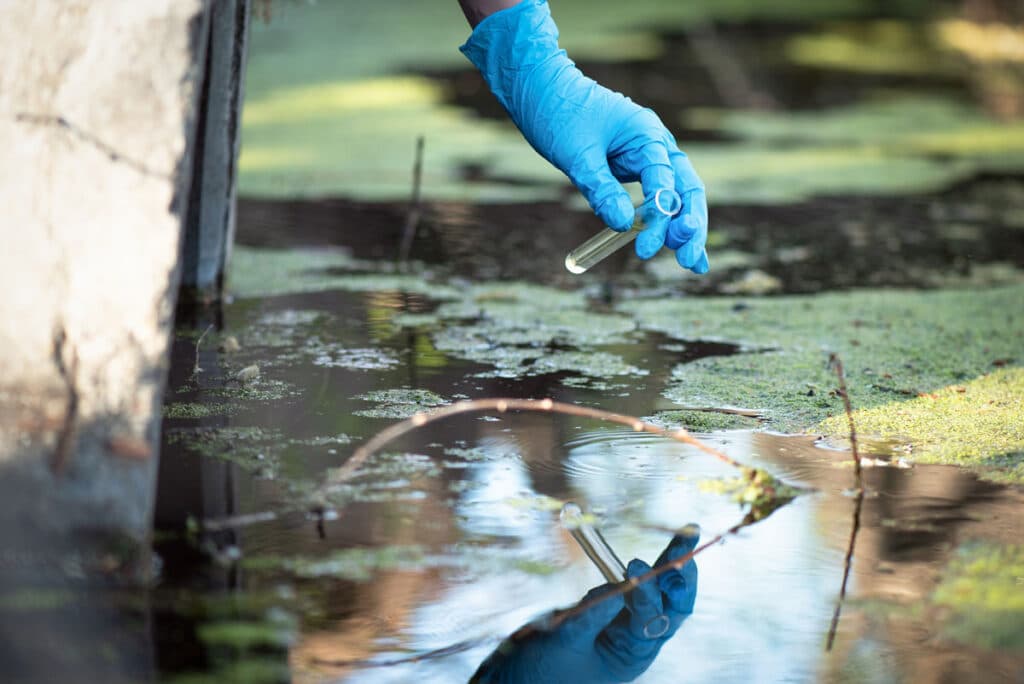Vapor Intrusion at Camp Lejeune
From 1953 and 1987, as many as a million or more Marine veterans, their families, and others who lived or worked at Camp Lejeune may have been exposed to toxic contaminants in the drinking water at the base. In addition to exposure through drinking, cooking, and bathing in the water, people at the base may have been exposed through a process known as vapor intrusion.
Volatile Organic Compounds
The four main chemicals that were found in the drinking water at Camp Lejeune, trichloroethylene (TCE), perchloroethylene (PCE), benzene, and vinyl chloride, belong to a class of chemicals known as volatile organic compounds, or VOCs.
VOCs are compounds that emit gases or vapors from solids and liquids. They have high vapor pressure, which means a lower boiling point and a faster evaporation rate. These human-made compounds also have low water solubility, which means the compounds don’t easily dissolve in water.
Industrial solvents and dry-cleaning agents are classified as VOCs. Petroleum fuels can also contain VOCs. In addition, VOCs like vinyl chloride can be byproducts of other chemical compounds.
Volatile organic compounds are frequent groundwater contaminants. Concentrations can be up to 10 times higher indoors than outdoors. Exposure to VOCs can have short-term and long-term health effects.
What is vapor intrusion?
Vapor intrusion is a process that occurs when vapor-forming chemicals such as VOCs enter overlying structures or buildings. These vapors can come from soil, groundwater, sewers, or drain lines, causing poor air quality.
At lower concentrations, chronic exposure of these vapor-forming chemicals from vapor intrusion can cause unacceptable health consequences.
Process of vapor intrusion
- A chemical spills or leaks into the ground, contaminating soil and groundwater
- The chemical can move with the groundwater and migrate under a building
- If the chemical is volatile, like VOCs, the chemical can vaporize or become a gas
- The gas can seep into nearby buildings, contaminating indoor air
Potential effects of vapor intrusion
If the contaminants in Camp Lejeune drinking water moved indoors, people who lived and worked at the base could have been exposed to the contaminants by breathing indoor air. Depending on the type and amount of chemicals, as well as the length of exposure, vapor intrusion can cause health effects.
Factors affecting vapor intrusion
Vapor intrusion does not always occur with contaminated groundwater or soil. Factors that impact whether or not there is vapor intrusion include:
- The type of soil beneath a building
- The type and condition of a building (foundation, leaks, air exchange)
- Weather conditions
The concentration of vapors can vary over time, changing by the hour, day, week, or seasonally. The amount can also vary by floor, in different rooms in the same building, or in adjacent buildings.
Vapor Intrusion at Camp Lejeune
The Agency for Toxic Substances and Disease Registry, a federal agency that is part of the Department of Health and Human Services, has been conducting a Vapor Intrusion Public Health Assessment at Camp Lejeune.
The inhalation of indoor air contaminants at buildings at Marine Corps Base Camp Lejeune may be a pathway to exposure of shallow groundwater contaminants at the base.
Vapor Intrusion Public Health Assessment
The Vapor Intrusion Public Assessment has two objectives:
- To evaluate whether current or past exposures to indoor air contamination from vapor intrusion may have harmed the health of people exposed at the base
- To evaluate the effectiveness of current systems that have been installed in some buildings at the base. The systems were designed to reduce indoor contaminants.
ATSDR is currently evaluating approximately 190 buildings of the roughly 14,000 buildings at the base. The agency first evaluated the entire base to prioritize buildings, applying various vapor intrusion factors to focus on buildings with the greatest concern for impact.
If the investigation concludes that vapor intrusion at the base has harmed or is harming health, the agency will recommend public health actions. The agency is expected to release the results of the assessment in the summer of 2022 and will release a final report following public comments.
For additional information on vapor intrusion:
U.S. Environmental Protection Agency
• Vapor intrusion website, visit: http://www2.epa.gov/vaporintrusion
Interstate Technology & Regulatory Council
• Vapor intrusion website, visit: http://www.itrcweb.org/Team/Public?teamID=22
Agency for Toxic Substances and Disease Registry
• Investigating vapor intrusion, visit: https://www.atsdr.cdc.gov/docs/atsdr_vapor_investigation.pdf

